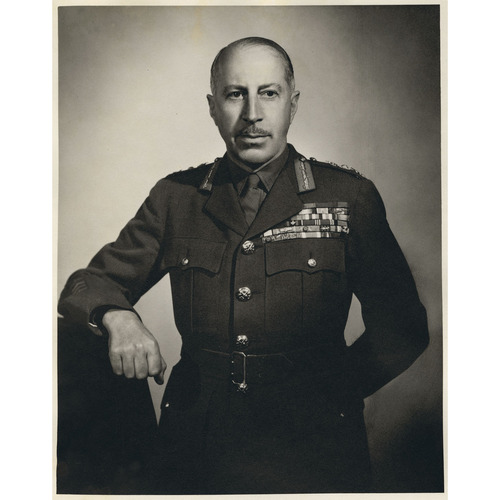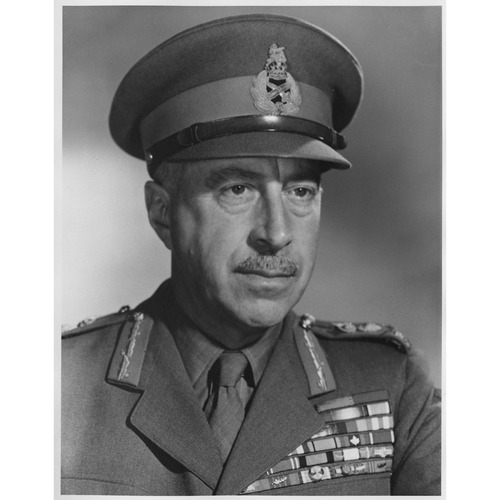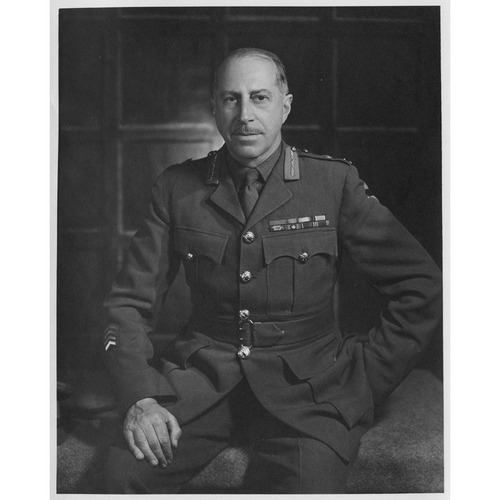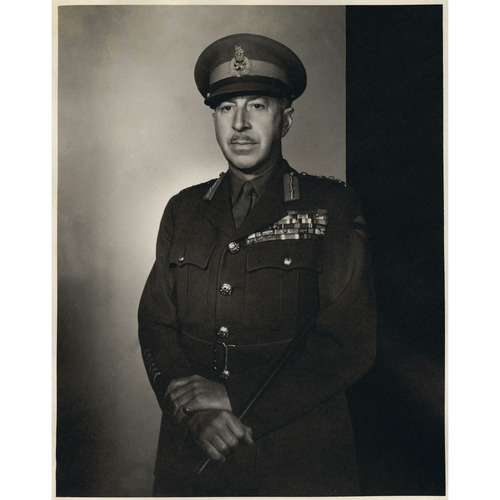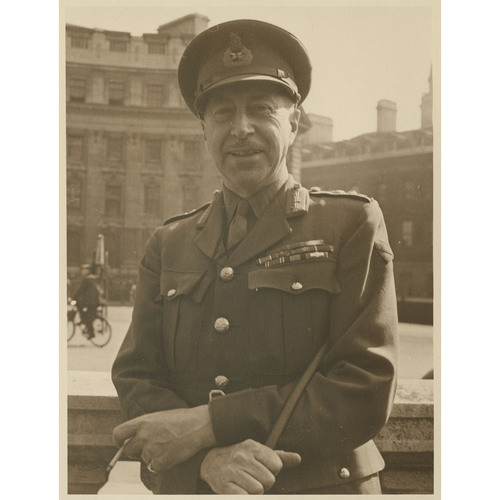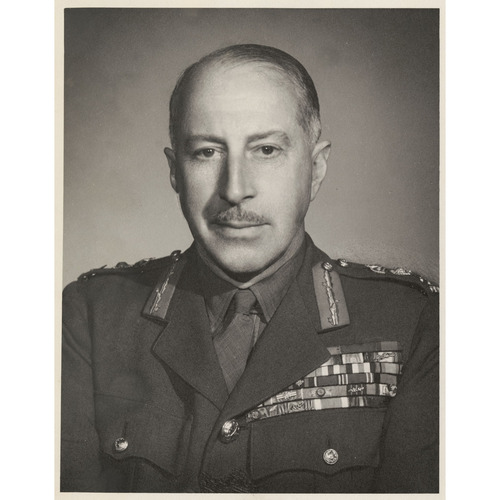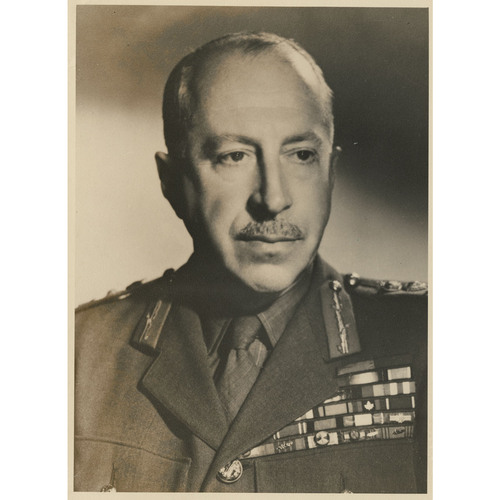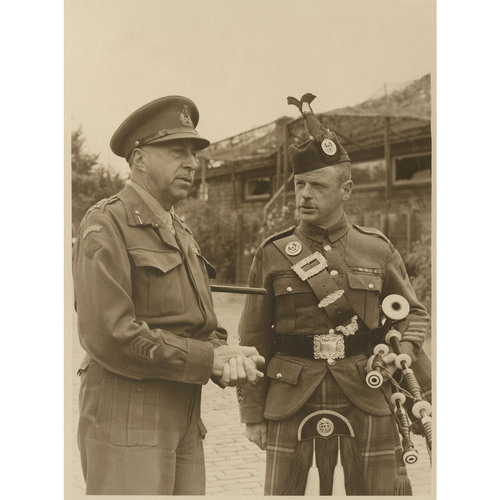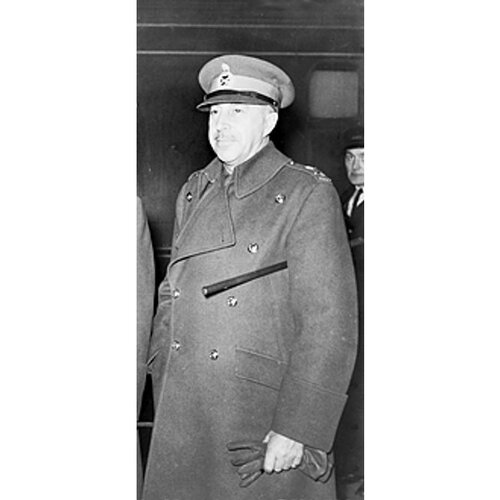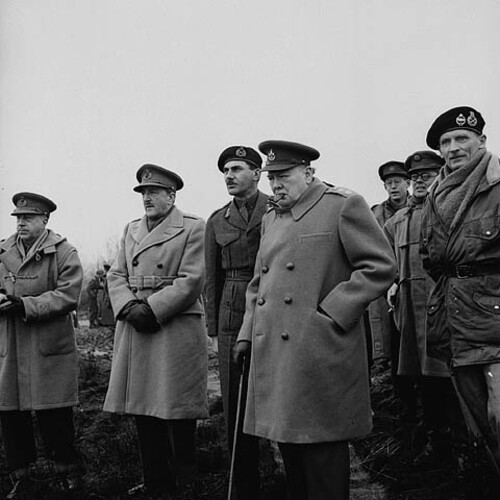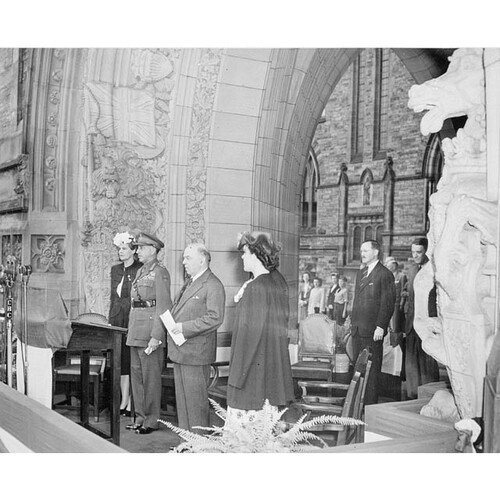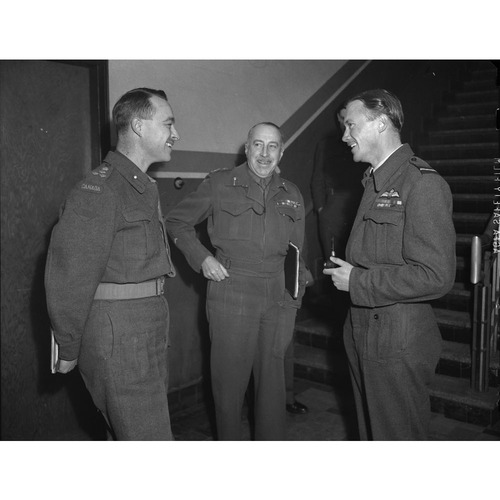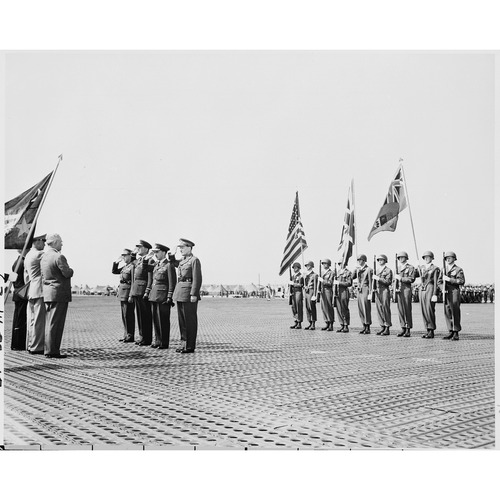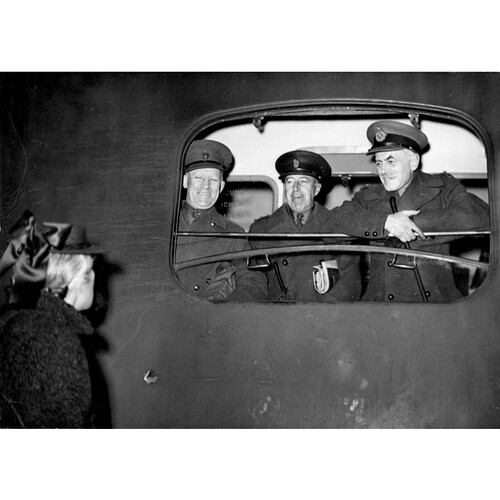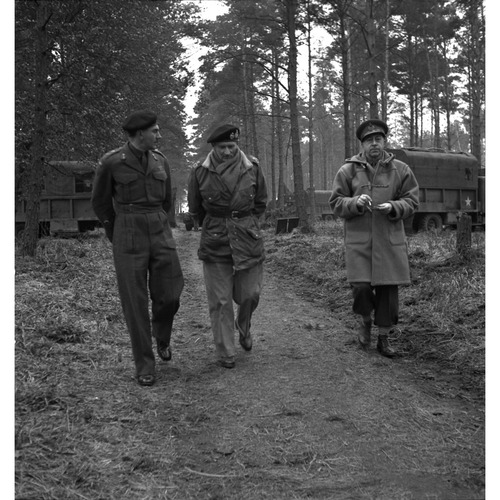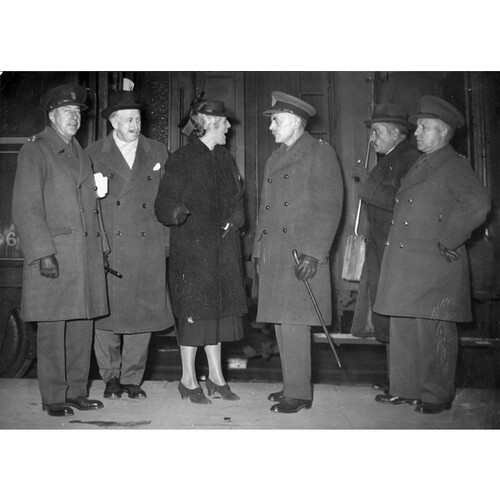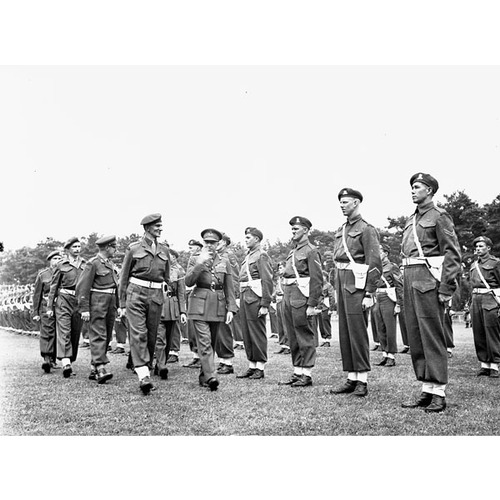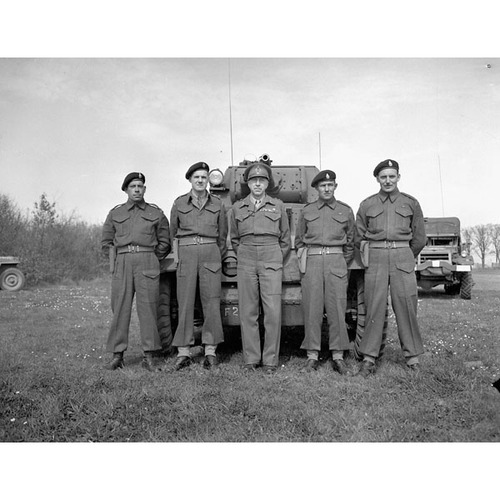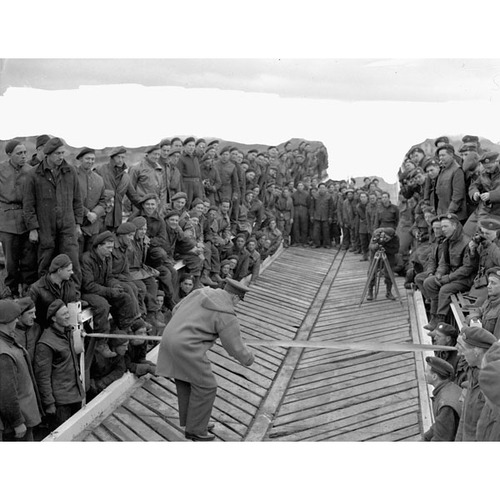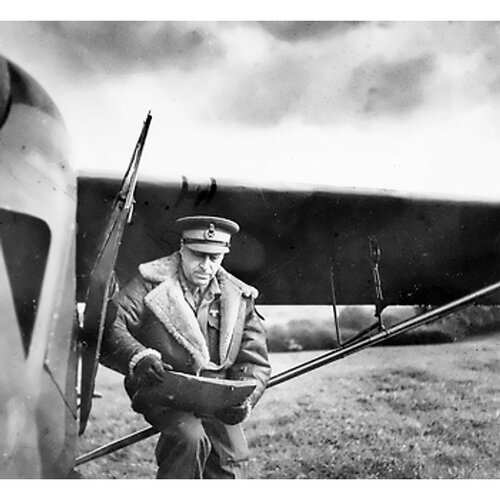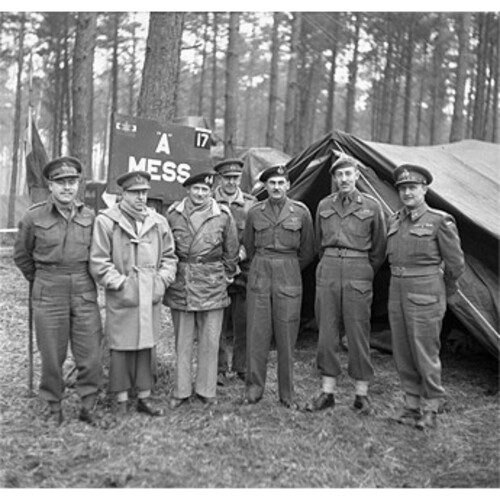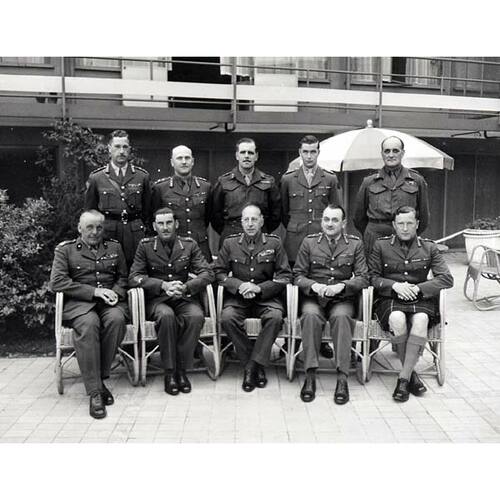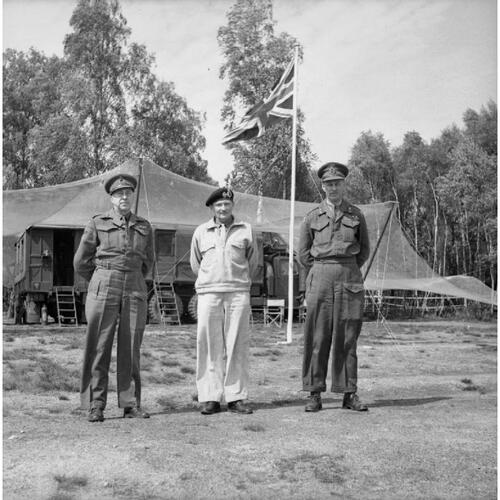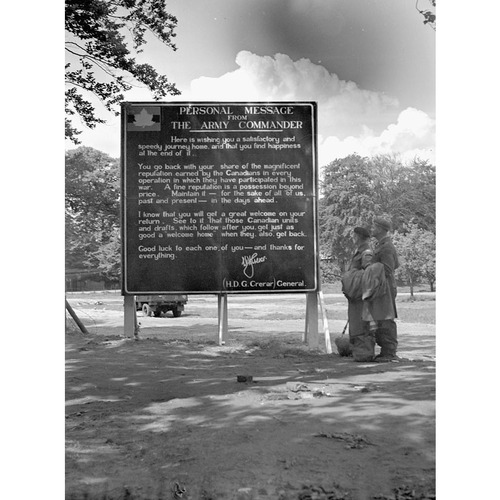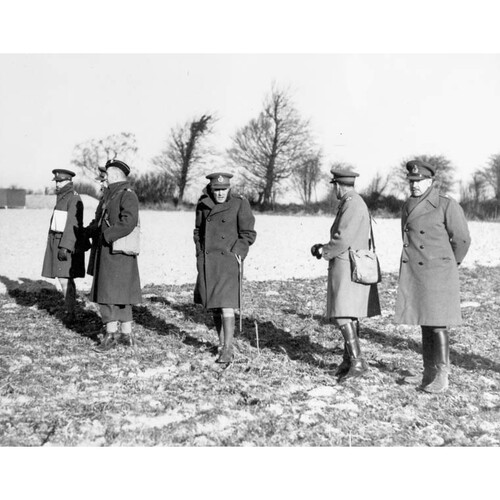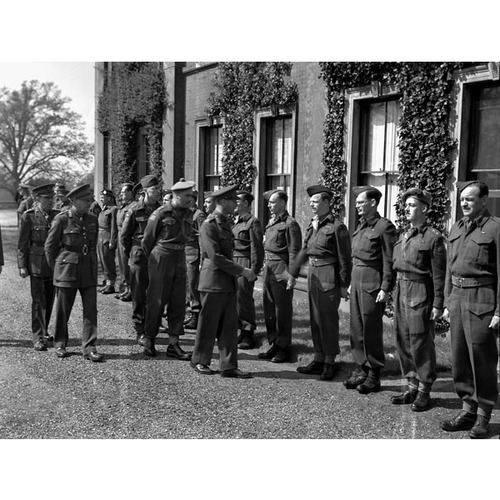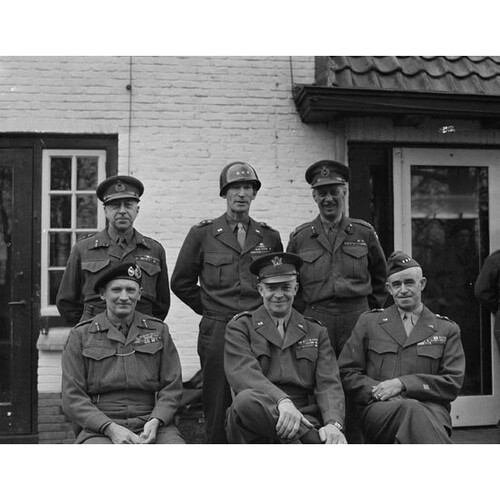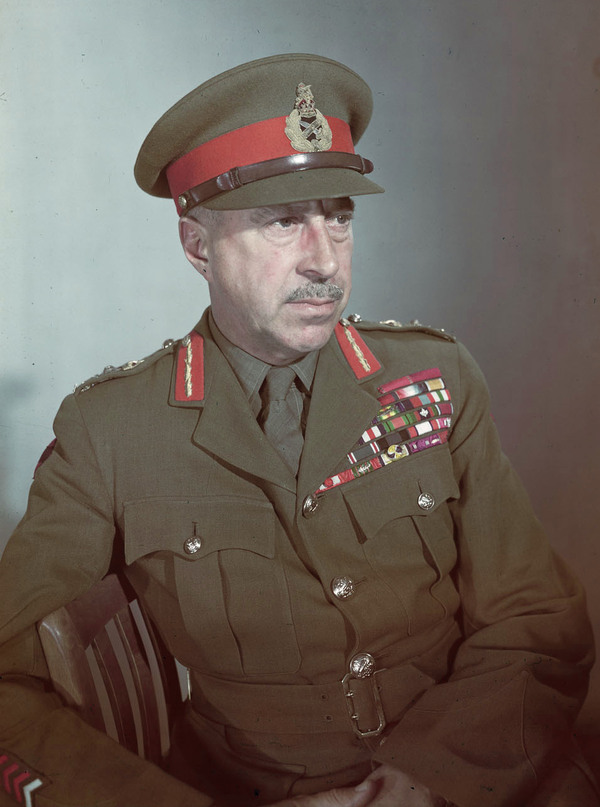
Source: Courtesy of Wikimedia Commons
CRERAR, HENRY DUNCAN GRAHAM, militia officer, businessman, and army officer; b. 28 April 1888 in Hamilton, Ont., second child and eldest son of Peter Duncan Crerar and Marion Elizabeth Stinson*, widow of Cuthbert John Ottaway; m. 14 Jan. 1916 Marion Verschoyle Cronyn in Toronto, and they had two daughters, one of whom died in infancy, and a son; d. 1 April 1965 in Ottawa, and was buried there in Beechwood Cemetery.
Henry Duncan Graham Crerar was born into an imperialist, civic-minded, upper-middle-class family. His father, an immigrant Scot, had strong Liberal roots and greatly admired Wilfrid Laurier*, leader of the federal party; the Stinsons were Conservatives. Harry’s youth was unremarkable but privileged, although he disliked drawing attention to his family’s position and would not have characterized it as such. Contemporary photographs show lavish parties, gatherings of white-gloved women and brandy-sipping men on the well-groomed grounds of Dunedin, the family residence from at least 1906, and afternoons of billiards and high tea, with the household rhythm being supported by three live-in domestics. Newspaper society columns suggest that the Crerars enjoyed plays and opera, and they often entertained guests from the theatrical world. Travel in Canada and abroad was also part of their life, with visits to the Crerars’ ancestral home in Scotland and tours of the Continent. The family had a summer getaway on Loon Island in Lake Joseph in the district of Muskoka, a popular vacation area for wealthy Ontarians, where they passed summers filled with fishing, boating, and hunting. An accomplished rider, Harry attributed his early attraction to the military in part to his love of horses and horsemanship, which was fostered by his holiday stays in London, Ont., at the home of Adam Beck*, future head of Ontario Hydro, and his wife, Lillian Ottaway, Harry’s half-sister, who were both enthusiastic horse owners.
Harry’s father, a member of the Royal Golf Society of Canada and the Canadian Association of Amateur Oarsmen, communicated to him a passion for sport. Though a quiet man, he was always at hand, his son recalled, “with wise counsel.” Yet it was his mother who left the larger imprint. “Whatever I have accomplished,” he would say while visiting his hometown in 1945, “I owe in the greatest measure to my early life in Hamilton, and, in particular[,] to the influence and inspiration of my mother.” She had a strong sense of noblesse oblige that manifested itself in local philanthropy and support of the British empire, and her attitude towards public service would be mirrored by her eldest son even if it was expressed in different ways. He also adopted his mother’s reserve and sense of propriety.
Crerar had fond memories of Hamilton. In 1899 the 11-year-old left for Upper Canada College in nearby Toronto. His mother’s parting gift was a daily meditation guide by Eleanor Plumptre, The words of the Son of God … (London, 1877); he kept it until he died, but there is no evidence that he read it. UCC was a mixed experience. Stephen Butler Leacock*, who was teaching there, would remember meeting the newly arrived boarder. “He wasn’t feeling so good,” Leacock wrote many years later, “just sitting on the edge of the bed and looking downhearted.” To console him, Leacock spoke of his admiration for Hamilton, which brought tears to Harry’s eyes. “Neither my scholastic nor sporting career at UCC,” he would confess in a speech at his former school in November 1945, “was such as to give marked satisfaction and pride to either parents or masters.” He was, however, an enthusiastic participant in the athletics program. His competitive disposition, slim build, and unimpressive height (eventually 5 feet 8 inches) made him liable to injuries: a broken leg during a rugby match in his second year and a fractured ankle during a hockey game the next year. As he would explain in 1940 to journalist Michael Grattan O’Leary*, “those accidents rather put me out of the running for the school teams,” but they did nothing to dampen his spirit.
His experience at the most elite school in Ontario, if not Canada, produced in Crerar a belief in the value of sports and education in building character and creating success. UCC was flourishing around the turn of the century under George Robert Parkin*, the prominent educator and British imperial advocate. Crerar was more influenced by two well-known masters: William Lawson Grant* and Edward Robert Peacock. Their loyalty to the British connection was real but pragmatic; they understood that the empire was evolving and that its relationship with the dominions would be limited by their growing autonomy and nationalism. Crerar maintained a formal contact with Grant, speaking of him with respect and often quoting his opinions on imperial organization and education. He had a warmer rapport with Peacock, and during both world wars he would frequently retreat to the latter’s residence in England to escape the pressures of his responsibilities. Echoing his former teachers’ views, he emphasized the benefits that Canada and the empire could enjoy if there were closer ties based on mutual knowledge and understanding of their shared and distinct pasts.
Crerar left UCC in 1904 for a year of study in Switzerland, possibly to better his grades and broaden his horizons. In 1905 he took classes at Hamilton’s Highfield School to improve his scholastic record, and in August that year he applied to the Royal Military College of Canada in Kingston. Crerar’s three years at RMC were among the most important of his life; there he began to develop the discipline and the perseverance that would become evident later on. The college had been established in 1874 [see Edward Osborne Hewett*] to provide the active militia with officers to command and to train men in the non-permanent active militia, but it was also intended to create leaders in the fields of civil engineering, surveying, and physics. The importance of developing productive civilians as well as potential soldiers distinguished RMC, yet the emphasis on formal military education was not enough to overcome the common perception that intellect was considered secondary to character in those learning to command. The college was popular with English Canadian upper-middle-class families who desired for their sons an education that included moral and physical conditioning as well as discipline and scholarly attainment. Crerar’s own aptitude, revealed by the end of his second year, was in the practical areas of drill, signalling, gymnastics, and target practice; his academic strengths were in French and applied sciences.
The hazing system, which made senior cadets responsible for aspects of disciplinary action among the newer students, also influenced Crerar. In 1938, when he was college commandant, he would declare that “the object of the system … is the inculcation of self-control and self-discipline and the progressive development of leadership amongst the Gentlemen Cadets.” Self-control and self-discipline would indeed be key tenets of his approach to life, and his ideas on officer training would reflect his perception of their significance. His time at RMC gave him a high degree of respect for education as a major tool, not only in forming the individual, but also in shaping society; equally important, he made friendships that would endure through much of his adult life, such as the one with Arthur Edward Grasett, who joined the British army. Photographs suggest a cocky young man, pillbox hat tilted to the side; in one his head is slightly angled partly because of a broken jaw resulting from a wild toboggan ride down the slopes of nearby Fort Henry. Horseback riding and sailing in the local harbour filled many of his spare hours.
Crerar finished thirteenth in a class of 30, receiving medals in French, equitation, artillery, and gymnastics. After graduation in 1909 and a summer holiday in the Muskoka district, he followed parental advice and took a job as a superintendent with the Canadian Tungsten Lamp Company Limited of Hamilton (his father had been on the board of directors). This move was not entirely to his taste. He longed, as did many cadets, for the adventure and travel experienced by the British cavalry serving the British empire, but this was a path for top graduates with ample finances. Crerar was reluctant to burden his father, however, and this unwillingness, as well as his unspectacular grades, forced him into the more mundane artillery branch of the non-permanent active militia’s 4th (Hamilton) Field Battery, in which he took a commission as a lieutenant. His subsequent service coincided with a period of relative dynamism in Canada’s defence establishment. Laurier’s efficient minister of militia and defence, Sir Frederick William Borden*, was expanding the militia, and his policies were continued by the forceful Samuel Hughes* in the Conservative government led by Robert Laird Borden* following the 1911 election. The popularity of things military and the increasing threat of a war in Europe translated into better facilities, equipment, and training for part-time soldiers. In communities such as Hamilton and Toronto, an officer in the militia achieved a degree of respectability.
Crerar was “sufficiently keen on my militia work” to faithfully attend, and pay for, the summer training camp in Petawawa from 1910 to 1914, with the exception of 1912; he became a captain in 1911. His battery was consistently characterized as “very good” and “well above average” in terms of efficiency, the turnout of the ranks, and the maintenance of equipment. He himself was praised in the annual reports on the Canadian Field Artillery as “keen, active and energetic,” and he would be described in a 1919 article in the Hamilton Spectator as “one of the most popular officers of the old 4th field battery.” His militia experience may not have prepared him for the conflict about to engulf Europe, but it did leave him with a firm impression of the importance, and limits, of part-time military service. Participation in the militia was a duty, an education, and a contribution to the defence of Canada and the empire.
The sudden death of his father on 9 June 1912 after an aneurysm changed Crerar’s pre-war world. His mother’s already-poor health worsened. These circumstances caused him to miss the militia’s summer training exercises that year. He moved to Toronto, lured by brother-in-law Adam Beck’s promise of a management position with Ontario Hydro, which was flourishing. His father’s passing had weakened his ties to his hometown, and he was anxious to put to use the knowledge he had gained with the Canadian Tungsten Lamp Company. He enjoyed an active social life when he was not overseas doing research for his job or in Muskoka on holiday. A member of the University Club of Toronto, he took every opportunity to golf; a frequent partner was a young law student, Reginald John Orde, a future judge-advocate-general in the armed forces. He also courted an attractive, fun-loving debutante seven years his junior, Marion Verschoyle Cronyn. Verse, as she was known, was the great-granddaughter of the Church of England clergyman Benjamin Cronyn*, a pioneering bishop in Ontario’s Huron County. Her father, Benjamin Barton, was a successful businessman in Toronto.
When war was declared against Germany in August 1914, Crerar volunteered to defend the British empire as part of the Canadian Expeditionary Force. He was enthusiastic, even jingoistic, but experience would quickly blunt his eagerness to fight “the Hun,” a transition captured in the journal he kept for the first 15 months of World War I. Despite the difficulties of transporting men, equipment, and horses from Hamilton to the military base at Valcartier near Quebec City, the infectious atmosphere of excitement was Crerar’s most vivid recollection of this period. Many gathered to see the trains pull away; the troops were cheered at every stop. “I never saw such a crowd,” he noted on 31 August, “and the few minutes we were there will long stay in my memory.” Indeed, the contrast between the enthusiasm of his departure and the mournfulness of his return a little less than five years later would infuse in him a determination to have the military’s contributions recognized and remembered, a determination that animated much of his professional post-war agenda.
Crerar had taken time from the chaos of reorganizing his battery only to secure his engagement to Verse, and he embarked for Europe early in October 1914. After a cold, wet winter on Salisbury Plain in England, in February 1915 Crerar and his troops – now the 11th Battery – arrived in Flanders as part of the 1st Canadian Division. His initial experience of combat, and near-death, came during the second battle of Ypres in April–May 1915 [see Sir Edwin Alfred Hervey Alderson*; Sir Arthur William Currie*], when more than 6,000 men became casualties, among them a large number of his friends from Hamilton. On 22 April, after being gassed and blown over as he sped forward on a bicycle to move his men, he was stunned but unhurt; staggering up, he clutched a pebble he would keep for the rest of his life as a good-luck charm. When he paused to reflect on the carnage, he was appalled. “I really don’t believe,” he recorded in his diary on 29 April, “any of us expected to have endured a week of battle such as this one has been.” The vicious fighting and the loss of many of his company made an indelible mark on Crerar. His journal entry of 15 June captures some of his feelings: “War is so very truly hell and this yard by yard fighting finds it at its worst. The gains are so small when it comes to distance – it just resolves itself into a case of counting corpses, if we have fewer than they, it’s a ‘victory.’” The experience also left him with a bitter hatred of Germany – “We’ll beat them some day but they’ll never be able to pay their just debt, the swine, not in this world anyway.” His loathing continued unabated through World War II; in 1945 he would refuse to meet any of the German commanders, allowing his subordinates to accept their surrender.
Having endured the shock of his baptism of fire, Crerar fought with great distinction in the Canadian Corps. The artillery in which he served earned acclaim in a formation that itself won no small number of accolades amongst the British imperial forces. During 1915 and 1916 loyalty to his troops and his hometown shaped his actions. Informally approached soon after the second battle of Ypres about what he saw as his future following the “permanent end of the game,” he noted in his journal that while he was reluctant to refuse an advance in rank, he “hated the thought of leaving the Hamilton crowd.” However, he was recommended by his commanding officer, Lieutenant-Colonel James Henry Mitchell, as particularly qualified for an army staff appointment. In August 1915 Crerar was attached to the divisional general staff “for instructional purposes.” When his assignment was completed at the end of the month, he chose temporary command of the 10th Battery even though a staff appointment was the faster route to promotion. His tenure ended in the fall, and on 25 March 1916 he returned to the 11th as a major and in command.
Crerar stayed with his men through that year and into the next. During the battle of Vimy Ridge [see Julian Hedworth George Byng*] in April 1917, he was appointed temporary commander with the rank of acting lieutenant-colonel of the 3rd Brigade, Canadian Field Artillery, when the commanding officer was wounded; he earned a mention in dispatches and a Distinguished Service Order. Personal circumstances – his marriage to Verse in 1916 and the birth of their daughter Margaret Elizabeth (Peg), the death of his younger brother Malcolm Charlton in August 1917 (his other brother, Alastair John, would be severely wounded the following year), the cumulative impact of the loss of the majority of the friends who had gone to war, and a desire to be in a position to join the Permanent Force after the war’s end – prompted him to begin exploring the possibility of moving to the divisional staff. In July 1917, following a seven-week course at the Staff College in Camberley, England, he was recommended as brigade-major for the recently formed 5th Canadian Divisional Artillery, and in his new command he returned to the front in September. Hard-working, methodical, and attentive to detail, Crerar quickly climbed the depleted ranks of the staff of the Canadian Corps to become the key artillery staff officer at the corps headquarters, where he arrived on 21 June 1918. Crerar had already come to the notice of two rising stars, Lieutenant-Colonel Andrew George Latta McNaughton, the corps counter-battery staff officer, and Major Alan Francis Brooke, senior officer of the British Royal Artillery. He became friends with both men, but it was McNaughton’s mentorship that would be most important to Crerar’s advancement. He soon proved himself. His organizational work, defence schemes, and barrage plan for the Amiens offensive launched on 8 August – the “black day of the German army” – earned him praise from colleagues, not least the acerbic and critical Brooke, and promotion to full lieutenant-colonel. On 10 November, the day before the war ended, Crerar succeeded McNaughton and thereby won further accolades and recognition.
World War I was traumatic for Crerar and his family despite his professional success. The stress caused by her three sons’ service in Europe and the loss of Malcolm contributed to his mother’s death in May 1919. Her illness had brought Crerar an early repatriation in March, but he had bitter memories of his battery’s return. Speaking in 1946, he recalled: “In the late summer of 1919, I went down to the old Grand Trunk Station at Hamilton, to welcome back my old Battery – the Eleventh. When the regular train pulled in, rather late, on a wet night, about a dozen weary gunners stepped down from a second class carriage. This little party of men was all that returned to Hamilton of this fine Battery which had moved, some two hundred strong, out to war … That episode then put a lump in my throat and a thought in my mind … I was determined that no soldier in First Canadian Army [which he would command in World War II] would repeat that experience.”
The war cemented in Crerar’s mind the belief that a strong, or at least professional, military was necessary to protect Canada’s interests and promote its sovereignty. He was as proud of the record of the Canadian Corps as he was distraught at the cost of obtaining it, and his feelings would influence his perception of the next two decades as he watched professionalism dissipate despite the desire of Sir Arthur Currie and like-minded officers to keep experienced men in the post-war army. Adding to his concerns was the growing distance between the British and Canadian armies and its possible impact on Canadian defence preparations. Crerar would highlight what he saw as a dilemma in a speech given on 31 March 1926 to the Royal United Services Institution in London, later published in the Canadian Defence Quarterly: “The Great War terminated with the military forces of the Empire a unified fighting organization.… [Despite the current divisions] … when war again threatens … our responsibility as soldiers stands clear – against that day to prepare the military machinery of the Empire for its highest effectiveness.” His frustration would be heightened both by the international tensions that characterized the late 1930s and by the vacuum in defence and military policy left by Canada’s growing autonomy from Britain.
In 1919, aided by a legacy from his mother’s estate that enabled him “to think more of what I’d like to do and less of what otherwise I might be compelled to do,” Crerar had decided to pursue a career in the Permanent Force, and in March 1920 he became staff officer, artillery, to the deputy inspector-general of artillery, Sir Edward Whipple Bancroft Morrison*, in Ottawa. He worked hard at his responsibilities, which included implementing the reorganization of the permanent and non-permanent militia and the royal schools of artillery. In 1922 he ruffled feathers by proposing that the Royal Canadian Horse Artillery Brigade be renamed the 1st Brigade, Royal Canadian Field Artillery. Initially accepted, his idea was, in the end, rejected for largely sentimental reasons. Although he was disgruntled at his prospects during the 1920s, Crerar was lucky to spend part of the decade in the United Kingdom. There he made new friendships and reinforced those he already had with some of the leading individuals in the British army who would figure prominently in World War II. Two places in Britain’s Staff College were held open for Canadians, and Crerar, with Georges-Philéas Vanier, arrived in London late in 1922 and began the two-year course in January 1923. Following graduation, he landed a two-year appointment at the War Office. Crerar, with Verse and their two children (Peter Duncan had been born in 1922), lived in or near London during this period. Attached to Military Operations, he was in charge of the section dealing with home defence, his main responsibility being the organization of coastal batteries. His superior, Colonel Archibald Percival Wavell, described him as “an excellent officer of very great ability.” He hoped for a place on the general staff in Ottawa, and in April 1927 he assumed command of B Battery, Royal Canadian Horse Artillery, in Kingston while awaiting a vacancy. Instead, in October he was named professor of tactics at the Royal Military College, effective January 1928. His response to this posting provides a glimpse of both the ambition and the demons that drove Crerar. Viewing the professorship as a demotion and a negative comment on his abilities, he wrote indignant letters to Andy McNaughton, who was being groomed for the position of chief of the general staff (CGS). Crerar wisely vented most of his anger in a rough draft; at home, the children were warned to leave him alone. He wrote more temperate versions when communicating with other friends at the Department of National Defence, and sent them copies of recent positive appraisals. While insisting that he liked the work at RMC, he believed that the rank associated with the position meant that his superiors considered him not “as worth while as I used to be,” and he suggested that “in general interests, apart from my own, the case should be investigated.” Crerar’s overreaction illustrated his continual need for reassurance. “He rather underestimated his ability,” recalled his friend Orde. “Sometimes he gave me the impression that he needed a boost to deliver the goods.”
Calmed by reassurances that the appointment was not a demotion, Crerar settled into life at the college. He was a straightforward and effective lecturer, if somewhat prosy. His teaching career ended abruptly when McNaughton became chief of the general staff early in 1929. “After many years of waiting,” McNaughton wrote to Crerar, “we will now be able to get on with some of the ideas which brought you and I into the Permanent Force on re-organization after the War.” He made his wartime associate a senior staff officer at the Directorate of Military Operations and Intelligence, a position Crerar assumed on 1 May. His main responsibilities were to conceive policy options and organize the country’s preparations for war, tasks that involved producing papers on mobilization, memoranda summarizing Canada’s strategic positions in locations ranging from the Arctic to the Panama Canal, and analyses of the impact of international developments.
Crerar was an important player in McNaughton’s plan for increasing the military’s influence on defence policy. He stood out in an admittedly small group; the army section in the Woods Building at the Department of National Defence headquarters in Ottawa grew from 48 in 1929 to only 69 in early 1939. During this stage of his career he began developing his expertise in international and interimperial affairs. Public lecturing and work on subjects intended for political consumption tempered Crerar’s ideas on a number of issues. His perspective on Canada’s connection with the empire changed substantially in an intellectual sense. In speeches and correspondence, he placed the Canadian military’s international responsibilities in the context of developments of the 1920s, and endorsed the pragmatic view that emerged in 1926 from the Imperial Conference and the Balfour Declaration on the autonomy and equality of the dominions and Great Britain. He accepted the principle that dominion provisions for local defence constituted imperial defence, yet he continued to believe that Canada’s first line of defence was Britain, especially since the country profited from being able to draw on British military resources and institutions. Perceiving that Whitehall’s recognition of the benefits of equality was important, Crerar pressed, particularly on an unofficial level, for more personal contact with British officers. His involvement in 1931–32 with an interdepartmental subcommittee examining the implications of the Statute of Westminster for military ties between Britain and Canada deepened his appreciation of the changing relationship, and strengthened his conviction that these ties were valuable. Throughout the 1930s he would describe himself as a “British subject, and a Canadian national.”
In 1931 McNaughton suggested that Crerar’s future lay in the diplomatic field rather than the army, possibly because he wanted stronger connections with the Department of External Affairs. He proposed an assignment under Major William Duncan Herridge, Canada’s minister to Washington. Unconvinced, Crerar gave a lengthy and reasoned defence of his decision to stay in the army, citing the professional and financial difficulties of switching careers at the age of 43. He made it clear that he hoped to succeed, eventually, to McNaughton’s job. In 1932 he became military technical adviser to the Canadian delegation attending the League of Nations’ first, and largest, World Conference on Disarmament in Geneva. This appointment brought Crerar into contact with future luminaries such as civil servants Norman Alexander Robertson and Lester Bowles Pearson*, both of external affairs, scholar Escott Meredith Reid* of the Canadian Institute of International Affairs [see Newton Wesley Rowell*], and professor Francis Reginald Scott* of McGill University in Montreal. Crerar was recognized as a coming man despite the military’s glacial rate of promotion, a status confirmed when McNaughton nominated him to attend Britain’s Imperial Defence College in 1933–34. In May 1933 a third child, Susan Anna, was born to the Crerars, but she died the following month, and both Harry and Verse welcomed a change of scene. The family moved from the Ottawa suburb of Rockcliffe to a cottage 20 miles south of London (daughter Peg was already attending an English boarding school).
The purpose of the IDC, founded in 1927, was to foster a greater understanding of the higher direction of war and facilitate good relationships among the military forces and the civilian departments responsible for defence, World War I having revealed weaknesses in these areas. Over the course of a year, students dealt with strategic problems affecting imperial security in Europe, the Middle East, and the Far East by considering the strengths and weaknesses of the empire and its most likely antagonists. The curriculum’s emphasis fitted in with Crerar’s perspective on the major lessons of the war. Yet, while the IDC did not dissuade him of the importance of the imperial connection, he was disturbed by the narrow British view of imperial defence. He believed that the British failed to appreciate the new constitutional arrangement formalized by the Statute of Westminster in 1931.
Despite his misgivings, he did well at the college. Its commandant, Vice-Admiral Sir Lionel George Preston, described Crerar as popular and “among the first three of the twenty-six at the College,” while the confidential report written at the end of the year said that he was “an earnest and clever student of all aspects of inter-Imperial relations and of foreign affairs. His quiet determination and sound analysis have much impressed both staff and students by which he has done much to emphasize … the true position of Canada in defence matters.” Praise from senior British officers almost guaranteed Crerar’s appointment as director of military operations and intelligence when he returned to Canada early in 1935. He would hold this influential post until 1938, drawing up the plans that would shape the army during World War II and learning the political lessons that would inform his approach to army expansion. His agenda was ambitious. The international situation was deteriorating, and he argued for more effective defence preparations, which would mean changes to government policy and the military’s role within it. His eagerness for good communication with Britain sometimes overpowered the insights he had gained in Ottawa and London. For example, he urged McNaughton to encourage Prime Minister Richard Bedford Bennett* to visit the Imperial Defence College when he was in London, an encounter that would have horrified Under-Secretary of State for External Affairs Oscar Douglas Skelton*, who wielded a great deal of power and had long been suspicious of Crerar’s enthusiasm for imperial cooperation and commitment.
Reporting to the new CGS, Major-General Ernest Charles Ashton, and aided by exemplary officers such as Major Maurice Arthur Pope*, Crerar pressed forward. In successive papers on Canada’s military requirements, they re-established the general staff’s priorities. The army’s plan to dispatch an expeditionary force to fight abroad was part of Defence Scheme No.3, which Pope had begun to revise in 1934, and it quickly became central to mobilization strategy. Reorganizing the militia, creating better links to external affairs, exchanging information with counterparts in the British War Office, and, most important of all, developing government policy on defence preparations became fundamental.
During the mid and late 1930s Crerar worked hard to create a sense of urgency as the country slowly reversed the decline resulting from years of inattention to defence. He was calculating. To counter the impression that the military placed too much emphasis on defending the empire rather than defending the country, Canada’s dependence on Britain for expertise was presented, accurately, as increasingly necessary for a profession constrained both fiscally and politically, and as the logical alternative to total stagnation. While unpalatable to the Liberal government of William Lyon Mackenzie King*, who had become prime minister in 1935, the certainty of the Joint Staff Committee (of which Crerar was secretary) that Canada would become involved in the looming crisis in Europe demonstrated an understanding of the nation’s changed relationship with Britain and its implications for military policy that sometimes escaped external affairs officials such as Skelton and the department’s legal adviser, Loring Cheney Christie*. Crerar’s assessments of the deteriorating international situation also proved astute. His analysis of Nazi ambitions following a brief tour of Germany in June 1937 was an example. He concluded that Germany was a “highly dynamic nation, determined before long to break its present bounds and consequently, increasingly dangerous to European, and indeed, to world peace.” Privately, he declared that he was “both impressed and depressed with what I saw.” In October he forecast that despite European problems such as the Nazi threat to Austria and Czechoslovakia, there was little likelihood of a “Great War” involving the British empire during the next two years – but it would come.
Yet Crerar’s actions occasionally revealed surprisingly immature political antennae. In late 1936 he gave a closed talk on Canadian defence problems and the possibility of war with Japan, a sensationalized version of which was leaked to the media. He and other Permanent Force officers were gagged, and Crerar was forced to issue a formal apology to the Japanese ambassador. During the 1937 Imperial Conference in London the liaison between the Canadian and British military establishments that had been promoted by Crerar became an issue after Skelton drew King’s attention to how well informed the British were about Canadian plans. The prime minister consulted defence minister Ian Alistair Mackenzie*, but gave control of military information to external affairs. King also warned his senior military personnel, particularly Crerar, to avoid “any conversations … which could be interpreted … as being in the nature of a military commitment.” Crerar would remark several years later that he came close to resigning in 1937 out of frustration resulting from the interference of Major-General Léo Richer La Flèche*, deputy minister of defence. The military was kept at a distance from discussions of policy and strategy. Skelton and Christie strongly resisted the general staff’s efforts to establish interdepartmental subcommittees modelled on Britain’s Committee of Imperial Defence.
Although there were professional ebbs and flows, in the 1920s and 1930s life for the Crerars was, generally, much better than for most Canadians. Daughter Peg remembered the 1930s as “idyllic” and “surreal.” Verse and Harry shared a love of sailing, fishing, and tennis. During the summers they alternated between visiting his sister, Violet Marie, on Loon Island and spending time with Verse’s relations at Lake Simcoe. Aunts, uncles, and cousins often brought the number to 30 or more. Stays with Violet featured afternoon tea, semi-formal attire at lunch, and formal dress for dinner, all reminders of rituals from his early family years that Crerar did not introduce into his own home. His passion for golf grew; he was said to be unapproachable after a bad game.
Crerar was appointed commandant of the Royal Military College in August 1938. After two decades as a lieutenant-colonel, the promotion to temporary brigadier was welcome, and deserved. His tenure was marked by the visit of King George VI and Queen Elizabeth on 21 May 1939 and by his realization that he would not be there long. His time at the college was affected by the approach of war and his involvement in developing mobilization plans. Following the Munich Crisis in October 1938, he had recommended that the college’s role during a conflict be formalized. In subsequent months his part in defence preparations required him to spend, he calculated, three days a week in Ottawa.
When war broke out in September 1939, Crerar, fearing he would be forgotten, wrote to anyone who might help him get an overseas job. He need not have worried. During World War II he would successively occupy, and often define, senior staff and operational appointments. After lobbying in vain for a promotion to major-general, he was sent to England in October as brigadier, general staff; later, he was made senior combatant officer at the Canadian Military Headquarters. McNaughton became the general officer commanding the 1st Canadian Infantry Division and arrived in London in December. Crerar’s was a steadying if forceful hand during the phoney war in the winter of 1939–40. He established a good relationship with Canada’s high commissioner, Charles Vincent Massey, who acted as the communications channel for policies decided on by the government in Ottawa. Responsible for providing military information to the commissioner, Crerar had a clear idea of what was necessary to defeat Germany and was under no illusions that the war would be either short or won without a huge effort by the Allied armies. His staff included Colonel Percival John (Price) Montague and Lieutenant-Colonel Eedson Louis Millard (Tommy) Burns*. Knowing the importance of working well with the British, he gained in recognition and influence. His equilibrium contrasted with the volatility of McNaughton, yet they shared a belief in the need to advocate Canada’s autonomy.
In July 1940 Crerar returned to Ottawa as the army’s vice-CGS, although, he told McNaughton, he would have preferred a field command. The CGS, Major-General Thomas Victor Anderson, retired that month, which left Crerar at the head of the army’s planning and directing body, where he aggressively pursued ideas to expand the force and reorganize its training, logistics, and headquarters to improve efficiency. He also wanted to establish a foundation for a more professional army after the war, and felt that any changes not addressing this goal would be useless. He told James Layton Ralston*, who had become minister of national defence in July 1940 after the death of Norman McLeod Rogers*, that “we must not waste a moment in undertaking a thorough analysis of Canada’s post-war military requirements and in planning a defence organization which will produce our future service needs with a maximum of efficiency and a minimum of expense.” Privately, he was adamant that “the armed forces of Canada … will not be allowed to slip back into the stagnant backwaters of their pre-war existence.” During his tenure as CGS, one of his obstacles was Prime Minister King, who feared that casualties would lead to conscription, which had become an issue that divided the country during World War I [see Sir Robert Laird Borden]. Related to this problem was his struggle to ensure that Ralston heeded his advice and gave him support.
Crerar’s achievements as CGS were the work of a man at the peak of his form. The fall of France in June 1940 accelerated every aspect of Canada’s war effort. Under Clarence Decatur Howe*, the Department of Munitions and Supply, buttressed by crown corporations, began to pour out equipment and materials. During the summer Crerar succeeded in persuading Ralston to form the 1st Canadian Corps out of the two infantry divisions already in England and a soon-to-be-established armoured division; he proposed that a fourth infantry division and more armoured forces follow in 1941. He also urged that recruits needed four months of compulsory training rather than 30 days, an idea that was accepted in principle in October. The following month Ralston left for London to confer with the British government on how Canada could best contribute to the overall war effort. On his return early in 1941 Ralston backed Crerar’s recommendations for an expanded army, to the latter’s satisfaction, and the War Committee gave its approval in a meeting on 8 January. His policy initiatives were complemented by his consolidation of the post of CGS as that of the government’s chief military adviser, a role which he believed critical for long-term stability.
Yet Crerar’s work as CGS also magnified his weaknesses. Despite, or perhaps because of, his successes, the prevailing impression left by his emphasis on his authority was that he was seeking personal power by striving to become “first among equals” in relation to the chiefs of the general staff’s administrative branches such as the master-general of the ordnance and the quartermaster-general. To Canadian politicians, it was irrelevant that his counterparts in Britain and the United States enjoyed the influence that Crerar sought because there were organizational differences and sympathetic commanders-in-chief in those countries. Crerar’s control over the selection of candidates for the senior staff openings created by expansion, and his insistence that he required a promotion to lieutenant-general to cement his standing, fuelled the perception of self-aggrandizement. Wilfred Victor Sifton, who became master-general of the ordnance on Crerar’s recommendation, confided in March 1941 to journalist Alexander Grant Dexter that “[Ralston] thinks Crerar is perhaps as good a soldier as we have available for the job in Canada but finds that he has grave weaknesses of character. He is immensely ambitious and is constantly seeking to arrogate to himself the whole business of the department.” The minister was frustrated, but felt helpless. In June Dexter suggested that Ralston “hates Crerar: despises the general staff from top to bottom.” Dismayed by the army’s continual call for more men, he was said to have admitted in October that “he was minister but must act upon the advice of his staff of professional soldiers. Being a civilian, he could not set aside his advisers simply because he disagreed with what they said. They knew; he did not know.” Furthermore, Ralston contended, “Crerar refused to give him any advice which would enable the present trainees to be usefully used.” Yet the minister ultimately supported Crerar’s proposals.
Crerar made enemies in his successful fight to expand the army and enhance its position. Ultimately more controversial was his support for the decision in the autumn of 1941 to dispatch two battalions from Canada to the British garrison at Hong Kong. The request came from Whitehall, which was anxious to send a message of deterrence to the Japanese. British intelligence overestimated the effect that a show of military readiness would have, and underestimated the likelihood that Hong Kong would be attacked. In the opinion of Crerar and others, there were moral and political considerations: Canada could not turn aside from potentially dangerous assignments that its allies were willing to undertake, and it was thought that an appearance of Commonwealth solidarity would have a deterrent effect that would make war with Japan less likely. He also believed that Canadian troops needed to get into the fight. Under the command of Brigadier John Kelburne Lawson*, soldiers of the Winnipeg Grenadiers and the Royal Rifles of Canada arrived on 16 November. The garrison fell to the Japanese on 25 December, and all Canadians were captured or killed. George Alexander Drew*, leader of the Ontario Conservatives, charged the federal government with incompetence, claiming that the men had been inadequately trained. Crerar, then in England, was called back to Canada in the spring of 1942 to appear before the royal commission established to investigate the disaster, and only the intervention of senior British and Canadian commanders kept him in London, where he answered written questions. The report by Chief Justice Sir Lyman Poore Duff* exonerated almost all concerned, including Crerar; Drew and others claimed that it was a whitewash.
Crerar had lobbied McNaughton for an operational post that would place him with troops waiting in Britain to be sent into battle. On 19 Nov. 1941 he had been rewarded with command of the 2nd Canadian Infantry Division in southeastern England following the retirement of Major-General Victor Wentworth Odlum*. In Ottawa Lieutenant-Colonel Kenneth Stuart* took over the general staff. On 23 December, promoted lieutenant-general, Crerar had become acting commander of the 1st Canadian Corps, replacing Major-General George Randolph Pearkes*, who had taken over temporarily from the exhausted McNaughton. The latter initially wanted Pearkes to stay in the job a little longer, until Crerar could gain more experience in divisional command, but Crerar’s promotion and British concerns about Pearkes changed his mind. Crerar was named general officer commanding the corps, which became the 1st Canadian Corps, on 6 April 1942 when the 1st Canadian Army headquarters was established under the recently returned McNaughton. The nation’s first (and only) field army, it was a remarkable achievement for a country with a population of only 11 million, and created thanks mainly to Crerar’s efforts. His tenure with the corps would last until 19 March 1944 and was characterized by a steady improvement in efficiency. He followed a number of approaches to make training more realistic and to weed out ineffective officers, taking much advice from and adopting many policies recommended by British lieutenant-general Bernard Law Montgomery, commander-in-chief of South Eastern Command, to which the 1st Canadian Corps had been assigned. Now Crerar’s immediate superior, Montgomery advocated the dismissal of a number of Canadian officers, including Pearkes. Crerar sought opportunities for operational experience for his men and himself in order to maintain morale, keep the army in the public eye, and satisfy the nation’s wish for Canadian action (many men had been in Britain for almost three years). Most important, he wanted seasoning for his untested troops and improvement of his own knowledge of battlefield command.
These motives informed Crerar’s support of Canadian involvement in small-scale raids, which culminated in the use of almost 5,000 Canadians under Major-General John Hamilton Roberts at Dieppe, France, on 19 Aug. 1942, one of the bloodiest days in Canadian military history. About 68 per cent of the troops who embarked were killed, wounded, or taken prisoner. Crerar, and others, felt that the lessons learned were well worth the tragic cost: in May 1944 King would record that Crerar had told him “much of the present plan [for the Normandy landings] was based on experience derived from Dieppe.” Crerar again emerged professionally unscathed from a military debacle. Indeed, his reputation grew as the 1st Canadian Corps evolved into a first-class fighting formation. Montgomery, no fan of Canadian senior command, declared that he had done “splendidly” in the important exercise “Tiger” (19–31 May 1942), and during “Spartan” (4–12 March 1943) he earned praise from his old friend Brooke, now chief of the imperial general staff. The events at Dieppe had made improved training Crerar’s primary focus and reinforced his desire for operational experience; he tried, unsuccessfully, to be sent to North Africa under Montgomery, who had taken over the 8th Army there on 13 August.
Continuing to believe that the Canadians had to be employed in an active theatre, Crerar became convinced that the chief obstacle was his mentor McNaughton, who had lost the confidence of British leaders because of what they perceived as a poor showing in Spartan. The growing estrangement between the two men was evident by the fall of 1942, Crerar being fully at odds with his commander’s insistence that Canadian troops had to fight as one formation rather than being divided into smaller units as Allied need dictated. Furthermore, Crerar, no longer content to be a protégé, resented McNaughton’s attempts to keep him out of policy matters. The relationship was poisoned as Crerar became increasingly involved in the British (and Canadian) campaign to have McNaughton removed. Stuart and others in Canada were aware of his concerns. On 31 March 1943 Crerar discussed the subject with Brooke, and he made his anxieties clear to Massey and Ralston. When the Canadian government authorized sending the 1st Canadian Infantry Division and a tank group to participate in the invasion of Sicily, McNaughton agreed after being assured that the troops would return before operations to invade the Continent began. The subsequent decision to send more men helped provoke a crisis. McNaughton felt that he could not support this choice, and, blaming Ralston and Stuart for what he considered underhanded conduct, he resigned as of 31 Dec. 1943 and then returned to Canada. Crerar, who valued loyalty highly, had been disloyal, but since he believed that McNaughton was no longer capable of doing the job, his choice was plain. Still, his nomination to succeed McNaughton was not assured. He was endorsed by senior British officers, including Brooke, although Montgomery refused his approval because Crerar had not demonstrated his capacity in battle, and others in British military circles, such as General Sir Bernard Charles Tolver Paget, doubted the utility of retaining a Canadian field army headquarters. They nevertheless bowed to Canadian sentiment and supported Crerar. As Brooke told Montgomery, “I had about 1½ intimate years with the Canadians in the last war & know well what their feelings are. They will insist that Canadian forces should be commanded by Canadians.” Suggesting that the Canadians were “very touchy and childlike,” he went on to say that “you will have to teach him,” but he was confident that Crerar would not let him down. Montgomery was less certain, although at this point he still liked Crerar on a personal level.
The liberation of Sicily was complete by early August 1943. The decision to employ the 1st Canadian Infantry Division and the 1st Canadian Armoured Brigade in the invasion of the Italian mainland had been confirmed; Canadian proposals to send Crerar, his corps headquarters, and additional armour (eventually the 5th Canadian Armoured Division) were debated for two months. Dispatching the 1st Canadian Corps to Italy was a political decision of limited popularity among the Allies. General Dwight David Eisenhower, supreme commander of the Allied forces in the Mediterranean, felt that he had no immediate need of an additional corps headquarters, while both his deputy, Lieutenant-General Harold Rupert Leofric George Alexander of Britain, who had not been consulted, and Montgomery complained that an additional infantry division rather than an armoured division would have been preferable. Eventually it was decided to accept the Canadian troops, and Crerar arrived on 29 October. His headquarters and men soon followed. Becoming fully operational on 1 Feb. 1944, the 1st Canadian Corps comprised the infantry division under Major-General Christopher Vokes* and the 5th Canadian Armoured Division, then under Major-General Tommy Burns. Bad weather and an Allied focus on operations in western Italy prevented Crerar from leading his men into action before he left on 4 March. The corps would fight on in Italy for another year.
He gained a solid reputation for reorganizing and stabilizing the corps headquarters, but he was also perceived as a stickler for procedure and discipline who vastly increased paperwork, a kindly “Uncle Harry” figurehead rather than a real field commander. He worked under Lieutenant-General Sir Oliver William Hargreaves Leese, who had succeeded Montgomery as the head of the 8th Army and, like him, was wary of the Canadian’s lack of experience. Crerar had a strained relationship as well with his brilliant if highly strung subordinate Major-General Guy Granville Simonds*, who was a protégé of Montgomery’s and, the latter believed, more suited to high command than Crerar. In December 1943 an acrimonious exchange of bizarre letters resulted from a trivial incident (Crerar had sent an officer to measure Simonds’s caravan so that he could have a similar vehicle constructed, and Simonds, who had been leading his division in combat in the central part of the island for some six months, reacted hotly). Concerned about the younger officer’s fitness for great responsibility, Crerar ordered a psychiatric assessment of Simonds, who was pronounced able to continue. Neither emerged unscathed from the dispute, but Crerar’s actions left Montgomery with no doubts about their relative capabilities.
Crerar returned to England and took over the 1st Canadian Army on 20 March 1944, when he started preparing for the part it was to play following the projected Normandy landings in June that would begin the Allied invasion of Nazi-occupied France. He made his mark on the army headquarters staff, pushed them hard, and again focused primarily on stabilizing, training, and planning, a process hesitantly initiated by Brigadier Clarence Churchill Mann and other senior officers. There was a tepid campaign designed to ease concerns over the change of command that included aborted attempts to portray him as the “Hamilton Tiger,” but Crerar was not comfortable with the public side of his appointment. Physically unimposing, he was reserved and correct, concerned with form and detail, his stiffness masking a shy, self-conscious man. Immaculate grooming that was almost fussy and a quiet, slow manner of speaking – “rather as if he was teaching a rather dull class” observed one subordinate – strengthened his stodgy image. He insisted that his officers and soldiers take similar pains with their appearance, convinced that it reflected and reinforced discipline, morale, and self-esteem. Yet Major Charles Perry Stacey*, who watched him castigate one of his men, felt that there was “an element of terror” in his method of command. Mann, who was chief of staff at 1st Canadian Army headquarters, recalled that Crerar never tolerated less than “maximum effort from any of his close subordinates.” These characteristics were complemented by a dry wit and blunt manner that won him the friendship and respect of many colleagues. Moreover, he was devoted to his troops, if not loved by them.
Crerar fought hard to have the British and other allies respect Canada’s autonomy. This attitude created political difficulties for Brooke, who was well aware of national sensitivities; Montgomery, now head of the 21st Army Group of which the 1st Canadian Army was part, would have preferred to treat forces from the dominions as British troops. One of his reasons for favouring Simonds was the latter’s focus on military considerations to the exclusion of political matters; this same trait was a source of concern to Crerar. He noted that “Monty’s primary interest is field command and not Canadian policies and business,” and he felt that Simonds was not sufficiently aware that senior Canadian officers were required to act as national representatives as well as military commanders. Throughout the spring of 1944 Crerar engaged in a rearguard battle against Montgomery’s attempts to replace him, a struggle that coincided with the period of Prime Minister King’s greatest nervousness over the possibility of a Dieppe-like outcome in Normandy. Only weeks before the invasion, Montgomery sought agreement from King, then in Britain, that military necessity must take precedence over Canada’s wishes for the integrity of its army and its commander; he singled out Crerar as a particular cause for concern. King conceded the point, although once back in Canada, he was more supportive of his army commander.
Despite the success of the landings, the campaign to break the German hold on Normandy developed slowly. The 3rd Canadian Infantry Division under Major-General Rodney Frederick Leopold Keller* had helped take Juno Beach on 6 June 1944, but the 1st Canadian Army became operational as a unified force only on 23 July. Crerar worked hard to influence the thrust into enemy-occupied territory, yet he lacked confidence in operational matters. One result was another dispute with a subordinate, this time with Lieutenant-General John Tredinnick Crocker, who commanded Britain’s 1st Corps under Crerar. Montgomery smoothed over the argument, but it gave him another reason to distrust the Canadian’s abilities. Crerar’s role in the final Normandy operations was limited. The commander-in-chief of the Allied ground forces during this campaign was Montgomery, who controlled the battle and communicated directly with Simonds and other subordinates while detailing what he believed to be Crerar’s shortcomings in his ongoing correspondence with Brooke. On 9 August he wrote that Crerar “is so anxious [for success in his first battle] that he worries himself all day!! I go see him a lot and calm him down.… He seems to have gained the idea that all you want is a good initial fire plan, and then the Germans all run away!!” As operations “Totalize” and “Tractable,” intended to crack the German position in Normandy, began in August, Crerar laid down some broad principles about objectives and strategy to Simonds, who filled in the details and made the plans work, and lectured on the need to maintain momentum. Crerar’s own part in Normandy and subsequent campaigns was shaped by his accountability to Montgomery as his superior officer and to the Canadian government, and he juggled his numerous and sometimes conflicting responsibilities admirably, although his insistence on his country’s autonomy hindered his ability to concentrate on operational matters. Over the course of the summer and early autumn he made regular trips to the front and dealt with an infantry shortage that left his formations, which now included Polish units, seriously weakened as the Allies were pressing their advantage over the collapsing enemy armies. He visited Canadian World War I memorial sites, his return to Vimy Ridge having personal as well as professional significance.
Montgomery, promoted field marshal on 1 September, was highly critical of Crerar and his headquarters staff during the pursuit of German forces as they retreated into Belgium. Crerar’s grip on the army was increasingly tenuous; by his own account, he was suffering from anaemia, the result of a prolonged bout of dysentery, and his decision-making capacity slipped. The widely shared belief that the Germans were nearly finished influenced his approach to operations along the left flank of the Allied armies: writing on 24 August to Brigadier Sherwood Lett, who had been wounded while commanding the 4th Canadian Infantry Brigade, he declared, “I believe that the toughest fighting is now over. Indeed, if we were not at war with a government of fanatics, an unconditional surrender would have taken place a week or so ago.” Adding to the complications of his command was the need for reinforcements, which was developing into a crisis that would become political, erupting in a dramatic cabinet meeting on 1 November during which King relieved Ralston of his duties as defence minister. He was replaced by McNaughton.
The problems facing Crerar and the 1st Canadian Army were exacerbated by inhospitable terrain and difficulties in securing supplies as the troops, on the western side of the Allied forces, turned north to advance along the coast and began crossing the Seine in the teeth of stubborn German resistance. The simmering tensions between Crerar and Montgomery exploded after the Canadian, asserting his prerogative as a national commander, decided to attend a memorial service at Dieppe rather than a conference of army commanders held on 2 September. During a stormy session the following day Montgomery insisted that their “ways must part.” He backed down when Crerar threatened to make the dispute a political issue. (Recalling such incidents, Crerar later told C. P. Stacey that “Monty would always go through a yellow light; but when the light turned red, he stopped.”) On the 4th Montgomery complained that Canadian operations were “badly handled and slow” in his report to Brooke; still, he later apologized to his subordinate for losing his temper. Nevertheless, Montgomery pressed the Canadians, multiplying their tasks while he diverted men and materials in preparation for Operation “Market Garden”: on 13 September he asked whether the Canadians could capture Boulogne, Dunkirk, and Calais as well as open the road to Antwerp. Struggling with his deteriorating health, Crerar sought to balance the needs of the coalition with those of his own army, but he did not pressure his commander for more resources. He cultivated good relations with his counterparts in the Allied forces and in the other Canadian services, a diplomatic approach that helped promote cooperation; he orchestrated a series of deliberately planned attacks that resulted in the capture of ports such as Le Havre and Boulogne, drawing on support from air forces and both navy and coastal guns. Historians have criticized him for this approach, despite the importance of the ports and the need to husband his diminishing resources.
By the end of September Crerar was exhausted. He was ordered to England for treatment, and left on the 26th. Simonds took over the army and assumed responsibility for capturing the Scheldt in Belgium and the Netherlands. During his recovery Crerar fought what could be characterized as the final British assault against the principle of Canadian national command. The issue was Tommy Burns’s fitness to lead the 1st Canadian Corps in Italy, a question that had arisen earlier that year. Burns relinquished command on 5 November, and was replaced by Lieutenant-General Charles Foulkes, who arrived on 16 November, after Crerar had received conclusive evidence of Burns’s unsuitability from his subordinates, major-generals Christopher Vokes and Bertram Meryl Hoffmeister*. But it was a Canadian decision, and Crerar was able to use the opportunity to defuse tensions between his commanders by switching Vokes to the 4th Canadian Armoured Division and Major-General Harry Wickwire Foster to the 1st Canadian Infantry Division in Italy. Meanwhile, Montgomery was trying to prevent Crerar from resuming his post, highlighting doubts about his health and his ability in messages to both Ottawa and London. Warned by Churchill Mann, Crerar consulted two specialists, who confirmed his physical recovery. Recognizing the undesirability of transferring command from Simonds until after the latter had cleared the Scheldt, Crerar, at Brooke’s request, delayed his return until November. When Crerar was promoted full general effective 16 November, Montgomery, in a petty act, wired Brooke asking him not to convey the impression that the new rank was “in any way for distinguished service in the field.” Crerar’s resumption of command was one factor that prompted Montgomery to order a feasibility study of moving the Canadian army after the completion of its operations in the Scheldt so that Lieutenant-General Sir Miles Christopher Dempsey and his British 2nd Army headquarters, and not Crerar, would control the upcoming battle for the Rhineland. The transfer proved logistically impossible.
Reinvigorated, Crerar imposed a firm grip on his headquarters staff and the plan to clear the Rhineland. He stayed silent through the political crisis over conscription in November 1944 [see King], but he developed a plan to ensure that the integration of conscripts would be as smooth as possible. However, his focus was largely on the Rhineland campaign. As much as anyone’s, Operation “Veritable” was Crerar’s. It was intended to destroy the northern German armies east of the Rhine. He would eventually have under him 13 divisions, 9 of them British, and an amalgam of Polish, Dutch, and Belgian units, the largest force ever commanded in the field by a Canadian. Understanding the historic nature of the battle, the British empire’s contribution to the winter campaign, and what could be described as the last British imperial army, Crerar instructed his staff to keep careful records and statistics. The assault was to begin in the early hours of 8 Feb. 1945. As the northern prong of Montgomery’s 21st Army Group, the 1st Canadian Army would launch its attack to coincide with the 9th United States Army’s “Grenade” offensive. The hope was that the German positions would be destroyed by the more than 1,000 guns engaged in the preliminary bombardment and the survivors then quickly driven back by the weight of Allied air power and armoured vehicles and the threat of being caught between the Canadians and the Americans. If weather and ground conditions were not good, Crerar envisaged a more deliberate three-stage operation, characterized by methodical preparation and overwhelming firepower – in short, a bitter battle of attrition. In either case, his army was ready.
Rain, mud, and the steadfast resistance of the enemy turned Veritable and the subsequent “Blockbuster I” and “Blockbuster II” into costly infantry conflicts. The Americans were unable to enter the fight because the Nazis had sabotaged dams and caused the Roer River to flood the whole of the American front, and their inactivity increased the pressure on the Canadian forces. Crerar was a steady and calming presence. His Vigilant aircraft, pockmarked by enemy fire, became a common sight as he flew to visit his subordinate commanders. Lieutenant-General Brian Gwynne Horrocks, leading Britain’s 30th Corps, recalled that “every day after the battle started he … came to see me wherever I might be. I grew to like him very much, though I am afraid I must have been a terrible pain in his neck, for during part of this long-drawn-out battle I was feeling very unwell.… The outward and visible sign was that I became extremely irritable and bad-tempered, yet Crerar bore with me very patiently.” Despite his unruffled demeanour, Crerar was noticeably aged and worn by his responsibilities. A chain-smoker for many years, he went through more cigarettes each day, and his cough would drive his batman from his caravan. After four years overseas, he was exhausted and felt isolated by his position. His increasingly frequent letters to family and friends were filled with descriptions of his dreams about his grandson, golfing, fishing, sailing, and Muskoka. His correspondence with his military colleagues declined.
By early March 1945 the struggle for the Rhineland was in its final stages, and Crerar was balancing the need to maintain pressure on the Germans with the terrible cost to his forces. He accepted the conflict as, like the Normandy campaign, another grinding battle to wear down the enemy. On 21 February he had written to Maurice Pope in Ottawa that “if our task has become heavier, for others it will be lighter. The situation is not unlike that which had to be met by the Army in July–August of last year.” Two days later the 9th United States Army finally launched its assault, and it made quick progress against diminished, if still stubborn, German resistance. By 10 March the Allied northern armies had reached the Rhine. The weather and ground conditions had been horrible, negating the Allied superiority in numbers and equipment. For almost two weeks British and Canadian soldiers fought their way forward in conditions as grim as any on the Western Front in World War I. The results of the battle were a vindication for a general who, only months earlier, had beaten back Montgomery’s numerous attempts to have him removed. The planning and control of the operations gave Crerar his finest hour as army commander. “Probably no assault in this war,” wrote Eisenhower in his congratulatory note of 26 March, “has been conducted under more appalling conditions of terrain than was that one. It speaks volumes for your skill and the valor of your soldiers, that you carried it through to a successful conclusion.” In his reply Crerar gave the credit to his men: “I believe that no troops could have put up a finer exhibition of enduring gallantry and determination than was demonstrated during those weeks of bitter, bloody and muddy fighting.” He was more restrained in private, noting that despite the atrocious conditions and cost, “we have accomplished the task … and … enabled other Armies to achieve striking advances with a minimum of enemy to contend with.”
The Canadian army’s subsequent operations focused on liberating the Netherlands, and feeding its starving population. In March the 1st Canadian Corps was transferred from Italy, reuniting all the Canadian units then in Europe. As hostilities drew to a close, Crerar ordered negotiations for local ceasefires so that food could be transported to the Dutch. His role would not be forgotten. On his return in 1948 to represent Canada at the coronation of Queen Juliana, he was greeted everywhere by parades and cheering crowds.
Crerar was thinking of the future. He wanted to make sure that neither knowledge of the Canadian army’s contribution nor its professionalism would fade as they had done after World War I. Since his approval or agreement was required for most questions of policy, issues of demobilization and repatriation, as well as Canada’s commitment to the war in the Pacific and to the occupation of Germany, together with consequent senior command appointments, were all affected by this goal. For example, he urged that demobilization be based on units rather than on individuals, an idea that was controversial, if understandable, given his memory of the dismal homecomings in 1919. The Canadian government’s concern with economic and political issues meant that his demobilization proposal was accepted only in part. Ultimately, the Cold War would do more than Crerar to secure his vision of a professional army, although he did exert some influence on the choice of his successors; most notably, he ensured that the diplomatic Foulkes would be the first post-war CGS, and not Simonds. This appointment was contentious, but Foulkes had the temperament required to deal with the King government, which slashed the military; moreover, his appointment probably guaranteed that the history of the army’s accomplishments in the war would be written since Foulkes supported Crerar’s choice of C. P. Stacey to record much of it.
Crerar had gone to London on 21 April 1945, leaving Simonds as acting army commander until his return on the 29th. It was Simonds and Foulkes who took the German surrender on 5 May, Crerar having refused to do so. In the euphoria of victory, even Montgomery sent a message of appreciation. Crerar arrived back in Canada on 5 August, and there was an official welcome in Ottawa on the 7th. He retired in 1946 to spend time with his family. His relationship with Verse had suffered during his long absence. He had promised her that they would put down roots in Ottawa when they purchased a home there in 1940. Still, he had rebuffed her requests to join him overseas, believing that he had to set an example for his subordinates. Verse had voiced her displeasure, and her letters came less frequently. His commitment to his promise now informed his decision to remain aloof from public life. He was also concerned about his health and his income; his attempts to gain unofficial government assistance were unsuccessful.
As far as the public was concerned, Harry Crerar faded into obscurity almost immediately. He was partly responsible for his marginalization. King offered him the post of lieutenant governor of Ontario; Crerar turned it down. He accepted a few directorships, but declined the opportunity to become chair of Ontario Hydro. Through the late 1940s he was called on for diplomatic missions; one included a trip to China, Japan, and Hong Kong, where he was appalled by the state of the military cemetery. For the sake of his wife, and, he argued, to retain his credibility as an apolitical commentator, he rejected other chances to assume a more active role in public service, although he attempted, without success, to gain an appointment to the Senate. Still, his financial situation was improving by the early 1950s. He helped out old subordinates with money and references, but he kept such actions private. His refusal to engage in technical military issues was prompted by a belief that he should devote himself to wider national causes, and he expected that he would be consulted unofficially on larger issues. But Crerar had also made enemies. He had wanted to showcase his personal caravan as a symbol of the Canadian army on a cross-country tour he had undertaken in late 1945 and then have it preserved as a historical artefact. According to one account, when staff of the minister of national defence and the CGS learned about the arrival of “eleven tons of the General’s personal vehicles … the order to have the lot shipped to London, Ontario … for disposal was issued ‘before Crerar [could] get his hands on it.’”
By the early 1950s he had become, not unlike the army he had led, a shadow of his former self, surrounded by reminders of past glories, but largely ignored. When he was interviewed it was as much for his brushes with great men as for his own achievements. In the latter part of the decade Crerar was rendered anachronistic by his commitment to civic education and by his pronouncements in speeches given to military institutes and branches of the Canadian Club, in which he favoured conscription and military education, attitudes that were out of tune with the country’s development. Citing concern for the privacy and reputations of others, he refused to write a memoir and was reluctant until the early 1960s to support a biography. He did, however, comment extensively on Stacey’s official histories, and viewed these as his memoirs. He also tried, unsuccessfully, to find an editor and funds to publish his talks and papers on constitutional development and defence issues.
Crerar believed that the predominant theme in post-war Canada was the emergence and evolution of a nationalism that distanced itself from its British origins. His emphasis on the importance of the British connection was no surprise given both his family background and his chosen profession. Like many of his contemporaries, he was rarely conflicted by being British and Canadian. He was more worried about social and political changes and how they manifested themselves in security and defence decisions. In March 1941 he had written to his son-in-law, Hamilton Zouch Palmer, about what he described as the “tremendous changes” during his lifetime “in the basis on which our own particular form of democracy has rested.” He feared that political wisdom was diluted by the extension of the vote to “pretty near everyone of both sexes who is not in a jail or an asylum” without a concurrent expansion in the educational system. Universal suffrage, combined with the 1910 decision to pay mps a salary, had, in Crerar’s opinion, “led to a lowering in the standard of outlook expected of a Member of Parliament.” Populist and constituency politics had displaced national politics; the solution was education in the ethics and principles of citizenship. He had seen how the “colossal power and influence of education” changed Germany, and fought men whose outlook had been “warped and fanatical.” He was afraid for the future, and he was not alone. Crerar belonged to a generation who found themselves compelled to define and then redefine what it meant to be Canadian in a national and international context created by two world wars and their aftermath.
Having been in poor health during the last decade of his life, Harry Crerar died on 1 April 1965. A photograph taken in the den of his Rockcliffe home that accompanied a newspaper obituary hints at the melancholy tinging his final years. Wearing a black tie, white shirt, and suit jacket, with his moustache neatly clipped, he sits in front of one of two display cabinets that show through their glass fronts a variety of medals and souvenirs gathered during a lifetime of accomplishments. The public persona was, as always, foremost. “One of my frustrations as a war correspondent … in the last European episode,” recalled reporter Robert Ross Munro* in a Toronto Star obituary (2 April 1965), “was my inability to get to know well the Canadian army commander, General Crerar … It was ‘H. D. G. Crerar’ and never ‘Harry.’”
Munro was not alone in his ignorance of the private Crerar. Few had insight into his personal life. He shunned the spotlight, never aspired to be a charismatic leader, and, to his credit, did not pretend to be something he was not: he once remarked that “generals are pretty much like other people.” Few figures rose from obscurity and fell back into it as fast as did the reserved, remote General Crerar. Yet no one had done as much as he did to shape the Canadian army during World War II. As CGS during the critical year and a half following the fall of France in June 1940, he was the primary architect of the 1st Canadian Army. He advised the government to dispatch troops to Hong Kong, he campaigned for Canadian involvement in the Dieppe raid, and he ultimately took charge of a combined Commonwealth army – the largest commanded by a Canadian – during the Rhineland offensive. His views on the form that Canada’s military contribution should take became policy, even though many, including the prime minister, initially opposed them. Crerar may have been calculating in the pursuit of his objectives, but he was also principled; his ambition was harnessed to what he believed to be a worthy purpose.
Understanding generals, like all leaders, depends on understanding the context in which they work. The responsibilities that go with the rank are as varied as the posts that are held, and they require a range of very different skills. From the fact that Crerar held Canada’s senior army staff and field commands, some conclusions can be drawn. First, he was intelligent and capable of learning on the job. He was no intellectual, but he was well read and thoughtful about his profession. Secondly, he was a skilled staff officer, with a penchant for order and discipline, and he defined several of his positions in ways that continue to offer guidance to military professionals. His appointments at the political–military interface enabled him to acquire a certain political acumen: for example, as CGS, he successfully manoeuvred his army programs past strong opposition, and he survived inquiries into the disasters at Hong Kong and Dieppe.
The skills required of a staff officer do not always translate into success in a field command; neither are the skills required for successful command of a brigade, division, corps, or army those that are needed by a staff officer. Crerar’s ability to lead a division or corps in battle was never tested. As a corps commander he was perceived as a paper pusher and a bit of a martinet, but he left the 1st Canadian Corps in good shape. Army command in modern warfare is as much about managing resources and understanding the implications of advances in communication and mechanization as it is about leadership and operational acumen. Crerar did not have a good grip on these aspects of his role in late 1944, but his leadership of the 1st Canadian Army during the Rhineland campaign in 1945 suggests that he had the ability to shape operations, and that he had learned a great deal in a short time. And, as one writer noted, he “fought that army competently against one of the fiercest armies ever assembled.”
As the chief Canadian commander in a British army group he was in a unique position, being accountable both to his government for the way in which Canadian soldiers were used, and to his allies for the way in which he worked with them. These responsibilities imposed limits on the exercise of his generalship, and it could be argued that he should have given up one role or the other. He did not, which indicates that, first and foremost, he was a nationalist. In late May 1944 he told Ken Stuart: “Though in practice I expect to be treated, and behave, as any other Army Commander, in principle I … am not. I am the Canadian Army Commander and, as such, am in a different category to the British Army Commander.” He saw his army as an instrument of the Canadian government and took a strategic view of its role; this perspective, as well as diplomatic skills, was required in coalition warfare at mid century. There was little scope for operational or strategic flair in the 21st Army Group, yet Crerar proved adept at the coalition game: he secured navy and air support for his depleted army in the fall of 1944, and he maintained solid relations with the majority of his counterparts.
As recent scholarship has highlighted, Crerar and the 1st Canadian Army were ultimately measured against the reputation won by the Canadian Corps during the Great War. This comparison is unfair: Crerar and the 1st Canadian Army, in operation for ten months, were not able to emerge from the shadow of the corps, its skill hard won over three and a half long and bloody years. This view may say as much about the historiography of the Canadian Corps in World War I, which tends to skim past the difficult period before the battle of Vimy Ridge, as it does about Crerar and his army. It is clear that Crerar learned steadily over 30 years, from his experiences during the second battle of Ypres in 1915 through to the final campaigns of 1945, and he adapted to the changing nature of warfare. Perhaps, though, his greatest legacy was his commitment to stewardship. During the 1920s and 1930s he fought to retain some shred of professionalism. Throughout the war he continuously worked to rebuild the military: to improve training, increase experience, and raise morale among Canadian troops, and to shore up the position of the army. His efforts were always undertaken with an eye to the post-war world, and his view was informed by his belief that the army was a critical civic institution.
Such was Crerar as a commander. Crerar as a leader of men was awkward and reserved. He did not inspire love, and he polarized opinion among superiors, peers, and subordinates: some regarded him as a kindly figurehead, others a hard-driving terror. He led, as he tried to live, by example, yet he was aware of his limitations, perhaps too much so, and, to his credit, worked to overcome them. Still, as a general, he was probably better than a country that starved its military during peacetime deserved.
Henry Duncan Graham Crerar published the following articles: “The difficulties of unified control of allied operations,” Canadian Defence Quarterly (Ottawa), 3 (1925–26): 71–74; “The development of closer relations between the military forces of the empire,” Canadian Defence Quarterly, 423–32; “War is a prospect Canada must face,” Maclean’s (Toronto), 15 July 1947: 7–8, 30–31, 33, 35; and “The case for conscription,” Queen’s Quarterly (Kingston, Ont.), 58 (1951): 1–13.
This profile is drawn from the author’s biography, A thoroughly Canadian general: a biography of General H. D. G. Crerar (Toronto, 2007) and Crerar’s personal papers (R5357-0-X), housed in Library and Arch. Can. in Ottawa, as well as private papers of B. L. Montgomery, 1st Viscount Montgomery (Imperial War Museum, London, PP/MCR/C30) and A. F. Brooke, 1st Viscount Alanbrooke (Univ. of London, King’s College, Liddell Hart Centre for Military Arch., GB99 KCLMA Brooke), among others. The record of Crerar’s birth (RG 80-2-0-299, no.39021) is available at Arch. of Ont. in Toronto.
While there is no other full-length study of Crerar, there are two very good chapters on him. One is in J. L. Granatstein, The generals: the Canadian Army’s senior commanders in the Second World War (Toronto, 1993) and the second is D. F. Oliver’s profile “In the shadow of the Corps: historiography, generalship, and Harry Crerar,” in Warrior chiefs: perspectives on senior Canadian military leaders, ed. Bernd Horn and Stephen Harris (Toronto, 2001), 91–132. Also important are C. P. Stacey, Six years of war: the army in Canada, Britain and the Pacific (1955) and The victory campaign: the operations in north-west Europe, 1944–1945 (1960), vols.1 and 3 of the Official history of the Canadian army in the Second World War (3v., Ottawa, 1955–60); S. A. Hart, Montgomery and “colossal cracks”: the 21st army group in northwest Europe, 1944–45 (Westport, Conn., 2000); and J. A. English, Patton’s peers: the forgotten allied field army commanders of the Western Front, 1944–45 (Mechanicsburg, Pa, 2009). The three-volume biography of B. L. Montgomery by Nigel Hamilton, Monty: the making of a general, 1887–1942 (London, 1981), Monty: master of the battlefield, 1942–1944 (1983), and Monty: the field marshal, 1944–1976 (1986), and War diaries, 1939–1945: Field Marshal Lord Alanbrooke, ed. Alex Danchev and Daniel Todman (London, 2001), give British perspectives on Crerar. See also the review of A thoroughly Canadian general … by Douglas Delaney in Canadian Military Journal (Kingston), 9 (2009), 4: 108–9.
Cite This Article
Paul Dickson, “CRERAR, HENRY DUNCAN GRAHAM,” in Dictionary of Canadian Biography, vol. 19, University of Toronto/Université Laval, 2003–, accessed January 19, 2025, https://www.biographi.ca/en/bio/crerar_henry_duncan_graham_19E.html.
The citation above shows the format for footnotes and endnotes according to the Chicago manual of style (16th edition). Information to be used in other citation formats:
| Permalink: | https://www.biographi.ca/en/bio/crerar_henry_duncan_graham_19E.html |
| Author of Article: | Paul Dickson |
| Title of Article: | CRERAR, HENRY DUNCAN GRAHAM |
| Publication Name: | Dictionary of Canadian Biography, vol. 19 |
| Publisher: | University of Toronto/Université Laval |
| Year of revision: | 2013 |
| Access Date: | January 19, 2025 |


